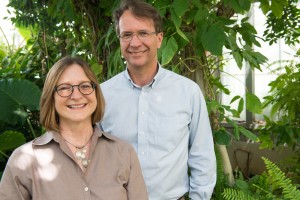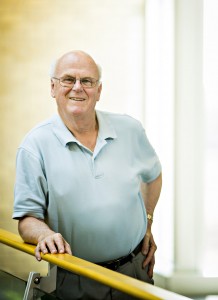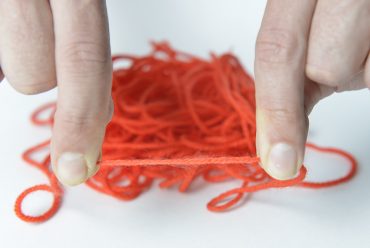Research

Aug. 25, 2014
Critical transport: Bond LSC team finds boron vital for plant stem cells, corn reproduction
Carbon’s next-door neighbor on the periodic table typically receives little attention, but when it comes to corn reproduction boron fills an important role. According to University of Missouri scientists, tiny amounts of boron play a key part in the development of ears and tassels on every cornstalk. The July 2014 edition of the journal Plant Cell published this research. “Boron deficiency was already known to cause plants to stop growing, but we showed a lack of boron actually causes a problem in the meristems, the stem cells of the plant,” said Paula McSteen, a Bond Life Sciences Center researcher.

Aug. 4, 2014
Viruses as Vehicles: Finding what drives
Graduate students Yuleam Song and Dan Salamango inoculate a bacteria culture in Johnson’s lab. The inoculation takes a small portion of a virus and multiplies the sample, allowing researchers to custom-make viruses. By Madison Knapp | Bond Life Sciences Center summer intern Modern science has found a way to turn viruses —tiny, dangerous weapons responsible for runny noses, crippling stomach pains and worldwide epidemics such as AIDS— into a tool. Gene therapy centers on the idea that scientists can hijack viruses and use them as vehicles to deliver DNA to organs in the body that…

July 16, 2014
Researchers flex new muscle in SMA drug development
By Paige Blankenbuehler Lauren and Claire Gibbs share contagious laughter, ambition and a charismatic sarcasm. Both are honor students at Shawnee Mission East High School in a Kansas City suburb. They also share a neuromuscular disease called spinal muscular atrophy (SMA), designated as an “orphan disease” because it affects fewer than 200,000 people in the U.S. However, the landscape for individuals with SMA is quickly changing with the development of new drugs. More than 7 million people in the United States are carriers (approximately 1 in 40) of the so-called “rare” neurodegenerative disease, SMA. Lauren,17 (left) and Claire, 16 (right),…

July 1, 2014
Hearing danger: predator vibrations trigger plant chemical defenses
Experiments show chewing vibrations, but not wind or insect song, cause response As the cabbage butterfly caterpillar takes one crescent-shaped bite at a time from the edge of a leaf, it doesn’t go unnoticed. This tiny Arabidopsis mustard plant hears its predator loud and clear as chewing vibrations reverberate through leaves and stems, and it reacts with chemical defenses. Plants have long been known to detect sound, but why they have this ability has remained a mystery. University of Missouri experiments mark the first time scientists have shown that a plant responds to an ecologically relevant sound in its environment. “What…

June 20, 2014
Nerve cell communication mechanisms uncovered, may lead to new therapeutic approaches for neurodegenerative diseases
Story by Madison Knapp/ Bond Life Sciences summer intern Simple actions like walking, swallowing and breathing are the result of a complex communication system between cells. When we touch something hot, our nerve cells tell us to take our hand off the object. This happens in a matter of milliseconds. This hyperspeed of communication is instrumental in maintaining proper muscle function. Many degenerative diseases affecting millions of people worldwide result from reduced signaling speed or other cellular miscommunications within this intricate network. Michael Garcia, investigator at the Christopher S. Bond Life Sciences Center and associate professor of biology at…

June 10, 2014
SoyKB: Leading the convergence of wet and dry science in the era of Big Data
Yaya Cui, an investigator in plant sciences at the Bond Life Sciences Center examines data on fast neuron soybean mutants that are represented on the SoyKB database. The most puzzling scientific mysteries may be solved at the same machine you’re likely reading this sentence. In the era of “Big Data” many significant scientific discoveries — the development of new drugs to fight diseases, strategies of agricultural breeding to solve world-hunger problems and figuring out why the world exists — are being made without ever stepping foot in a lab. Developed by researchers at the Bond Life…

June 4, 2014
MU Scientists Successfully Transplant, Grow Stem Cells in Pigs
New line of pigs do not reject transplants, will allow for future research on stem cell therapies Story by Nathan Hurst/MU News Bureau COLUMBIA, Mo. – One of the biggest challenges for medical researchers studying the effectiveness of stem cell therapies is that transplants or grafts of cells are often rejected by the hosts. This rejection can render experiments useless, making research into potentially life-saving treatments a long and difficult process. Now, researchers at the University of Missouri have shown that a new line of genetically modified pigs will host transplanted cells without the risk of rejection.

May 12, 2014
New screening tool gives scientists more control over genetic research
A tangled spool of yarn represents DNA, while the fingers holding the section represent the insulators just added by MU researchers to improve a scientific, screening tool. | Paige Blankenbuehler Here’s a scenario: You are trying to find a lost section of string in the world’s most massively tangled spool of yarn. Then try cutting that section of yarn that’s deeply embedded in the mess without inadvertently cutting another or losing track of the piece you’re after. For researchers, this problem is not unlike something they encounter in the study of genetic information in the tangled…

April 28, 2014
A drug that packs a punch: new compound works better against resistant HIV
Bond LSC researcher Stefan Sarafianos stands in the LSC atrium. The virologist is an associate professor of molecular microbiology and immunology and Chancellor’s Chair of Excellence in Molecular Virology with appointments in MU’s School of Medicine and the Department of Biochemistry. Resistance is the price of success when it comes to treating HIV. Virologists at the Bond Life Sciences Center are helping to test the next generation of anti-AIDS medication to quell that resistance. Stefan Sarafianos’ lab recently proved that EFdA, a compound that stops HIV from spreading, is 70 times more potent against some HIV…

April 25, 2014
Frogs help researchers find genetic mechanism for mildew susceptibility in grapevine
Powdery mildew on a cabernet sauvignon grapevine leaf. | USDA Grape genetics publications and research A princess kisses a frog and it turns into a prince, but when a scientist uses a frog to find out more information about a grapevine disease, it turns into the perfect tool narrowing in on the cause of crop loss of Vitis vinifera, the world’s favorite connoisseur wine-producing varietal. MU researchers recently published a study that uncovered a specific gene in the Vitis vinifera varietal Cabernet Sauvingon, that contributes to its susceptibility to a widespread plant disease, powdery mildew.
April 24, 2014
Chemical beacons: LSC scientist discovers how plants beckon bacteria to attack
Scott Peck, Bond LSC scientist and associate professor of biochemistry, studies Arabidopsis and how bacteria perceive it before initiating an infection. Roger Meissen/ Bond LSC Sometimes plants inadvertently roll out the red carpet for bacteria. Researchers at the University of Missouri Bond Life Sciences Center recently discovered how a plant’s own chemicals act as a beacon to bacteria, triggering an infection. Proceedings of the National Academy of Sciences published their study April 21. “When bacteria recognize these plant chemicals it builds a needle-like syringe that injects 20-30 proteins into its host, shutting down the plant’s…

March 21, 2014
MU researchers find key gene in spinal locomotion, yield insight on paralysis
Samuel Waters and graduate researcher Desiré Buckley review stages of embryonic development. — BLANKENBUEHLER The difference between walking and being paralyzed could be as simple as turning a light switch on and off, a culmination of years of research shows. Recently, University of Missouri Assistant Professor of biology Samuel T. Waters isolated a coding gene that he found has profound effects on locomotion and central nervous system development. Waters’ work with gene expression in embryonic mouse tissue could shed light on paralysis and stroke and other disorders of the central nervous system, like Alzheimer’s disease. Waters…